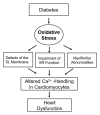Role of Oxidative Stress in Metabolic and Subcellular Abnormalities in Diabetic Cardiomyopathy
- PMID: 32244448
- PMCID: PMC7177292
- DOI: 10.3390/ijms21072413
Role of Oxidative Stress in Metabolic and Subcellular Abnormalities in Diabetic Cardiomyopathy
Abstract
Although the presence of cardiac dysfunction and cardiomyopathy in chronic diabetes has been recognized, the pathophysiology of diabetes-induced metabolic and subcellular changes as well as the therapeutic approaches for the prevention of diabetic cardiomyopathy are not fully understood. Cardiac dysfunction in chronic diabetes has been shown to be associated with Ca2+-handling abnormalities, increase in the availability of intracellular free Ca2+ and impaired sensitivity of myofibrils to Ca2+. Metabolic derangements, including depressed high-energy phosphate stores due to insulin deficiency or insulin resistance, as well as hormone imbalance and ultrastructural alterations, are also known to occur in the diabetic heart. It is pointed out that the activation of the sympathetic nervous system and renin-angiotensin system generates oxidative stress, which produces defects in subcellular organelles including sarcolemma, sarcoplasmic reticulum and myofibrils. Such subcellular remodeling plays a critical role in the pathogenesis of diabetic cardiomyopathy. In fact, blockade of the effects of neurohormonal systems has been observed to attenuate oxidative stress and occurrence of subcellular remodeling as well as metabolic abnormalities in the diabetic heart. This review is intended to describe some of the subcellular and metabolic changes that result in cardiac dysfunction in chronic diabetes. In addition, the therapeutic values of some pharmacological, metabolic and antioxidant interventions will be discussed. It is proposed that a combination therapy employing some metabolic agents or antioxidants with insulin may constitute an efficacious approach for the prevention of diabetic cardiomyopathy.
Keywords: Ca2+-handling abnormalities; cardiac metabolism; diabetic cardiomyopathy; oxidative stress; renin-angiotensin system; subcellular remodeling; sympathetic nervous system.
Conflict of interest statement
The authors declare no conflict of interest.
Figures



Similar articles
-
Subcellular remodeling and heart dysfunction in chronic diabetes.Cardiovasc Res. 1998 Nov;40(2):239-47. doi: 10.1016/s0008-6363(98)00186-2. Cardiovasc Res. 1998. PMID: 9893715 Review.
-
Mechanisms of subcellular remodeling in heart failure due to diabetes.Heart Fail Rev. 2014 Jan;19(1):87-99. doi: 10.1007/s10741-013-9385-8. Heart Fail Rev. 2014. PMID: 23436108 Review.
-
Subcellular remodeling as a viable target for the treatment of congestive heart failure.J Cardiovasc Pharmacol Ther. 2006 Mar;11(1):31-45. doi: 10.1177/107424840601100103. J Cardiovasc Pharmacol Ther. 2006. PMID: 16703218 Review.
-
Alterations in sarcoplasmic reticulum and mitochondrial functions in diabetic cardiomyopathy.Exp Clin Cardiol. 2012 Sep;17(3):115-20. Exp Clin Cardiol. 2012. PMID: 23620698 Free PMC article.
-
Role of AMP-activated protein kinase on cardio-metabolic abnormalities in the development of diabetic cardiomyopathy: A molecular landscape.Eur J Pharmacol. 2020 Dec 5;888:173376. doi: 10.1016/j.ejphar.2020.173376. Epub 2020 Aug 15. Eur J Pharmacol. 2020. PMID: 32810493 Review.
Cited by
-
Cardioprotective role of diacerein in diabetic cardiomyopathy via modulation of inflammasome/caspase1/interleukin1β pathway in juvenile rats.Naunyn Schmiedebergs Arch Pharmacol. 2024 Jul;397(7):5079-5091. doi: 10.1007/s00210-023-02921-8. Epub 2024 Jan 15. Naunyn Schmiedebergs Arch Pharmacol. 2024. PMID: 38224346 Free PMC article.
-
Nr2f2 Overexpression Aggravates Ferroptosis and Mitochondrial Dysfunction by Regulating the PGC-1α Signaling in Diabetes-Induced Heart Failure Mice.Mediators Inflamm. 2022 Aug 30;2022:8373389. doi: 10.1155/2022/8373389. eCollection 2022. Mediators Inflamm. 2022. PMID: 36081650 Free PMC article.
-
Dapagliflozin Suppresses High Glucose-Induced Proliferation, Oxidative Stress, and Fibrosis by Reducing Mettl3-Induced m6A Modification in Marcks mRNA.Cardiovasc Toxicol. 2025 Jan;25(1):110-120. doi: 10.1007/s12012-024-09945-3. Epub 2024 Nov 19. Cardiovasc Toxicol. 2025. PMID: 39560681
-
KLF9 Aggravates Streptozotocin-Induced Diabetic Cardiomyopathy by Inhibiting PPARγ/NRF2 Signalling.Cells. 2022 Oct 27;11(21):3393. doi: 10.3390/cells11213393. Cells. 2022. PMID: 36359788 Free PMC article.
-
Vanillic acid attenuates H2O2-induced injury in H9c2 cells by regulating mitophagy via the PINK1/Parkin/Mfn2 signaling pathway.Front Pharmacol. 2022 Sep 7;13:976156. doi: 10.3389/fphar.2022.976156. eCollection 2022. Front Pharmacol. 2022. PMID: 36160415 Free PMC article.
References
-
- Regan T.J., Ahmed S., Haider B., Moschos C., Weisse A. Diabetic cardiomyopathy: Experimental and clinical observations. N. Engl. J. Med. 1994;91:776–778. - PubMed
-
- Dhalla N.S., Pierce G.N., Innes I.R., Beamish R.E. Pathogenesis of cardiac dysfunction in diabetes mellitus. Can. J. Cardiol. 1985;1:263–281. - PubMed
Publication types
MeSH terms
Substances
LinkOut - more resources
Full Text Sources
Medical
Miscellaneous

